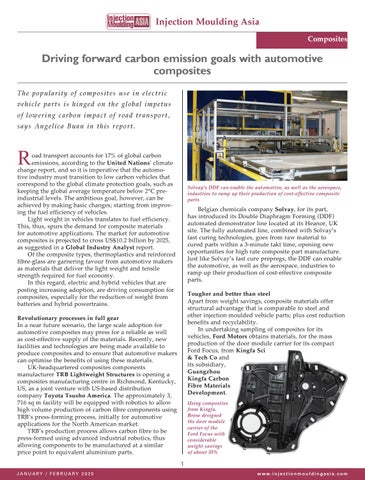Injection Moulding Asia Composites
Driving forward carbon emission goals with automotive composites The popularity of composites use in electric
vehicle parts is hinged on the global impetus of lowering carbon impact of road transport, says Angelica Buan in this report.
R
oad transport accounts for 17% of global carbon emissions, according to the United Nations’ climate change report, and so it is imperative that the automotive industry must transition to low carbon vehicles that correspond to the global climate protection goals, such as keeping the global average temperature below 2°C preindustrial levels. The ambitious goal, however, can be achieved by making basic changes; starting from improving the fuel efficiency of vehicles. Light weight in vehicles translates to fuel efficiency. This, thus, spurs the demand for composite materials for automotive applications. The market for automotive composites is projected to cross US$10.2 billion by 2025, as suggested in a Global Industry Analyst report. Of the composite types, thermoplastics and reinforced fibre-glass are garnering favour from automotive makers as materials that deliver the light weight and tensile strength required for fuel economy. In this regard, electric and hybrid vehicles that are posting increasing adoption, are driving consumption for composites, especially for the reduction of weight from batteries and hybrid powertrains.
Solvay’s DDF can enable the automotive, as well as the aerospace, industries to ramp up their production of cost-effective composite parts
Belgian chemicals company Solvay, for its part, has introduced its Double Diaphragm Forming (DDF) automated demonstrator line located at its Heanor, UK site. The fully automated line, combined with Solvay’s fast curing technologies, goes from raw material to cured parts within a 3-minute takt time, opening new opportunities for high rate composite part manufacture. Just like Solvay’s fast cure prepregs, the DDF can enable the automotive, as well as the aerospace, industries to ramp up their production of cost-effective composite parts. Tougher and better than steel Apart from weight savings, composite materials offer structural advantage that is comparable to steel and other injection moulded vehicle parts; plus cost reduction benefits and recyclability. In undertaking sampling of composites for its vehicles, Ford Motors obtains materials, for the mass production of the door module carrier for its compact Ford Focus, from Kingfa Sci & Tech Co and its subsidiary, Guangzhou Kingfa Carbon Fibre Materials Development.
Revolutionary processes in full gear In a near future scenario, the large scale adoption for automotive composites may press for a reliable as well as cost-effective supply of the materials. Recently, new facilities and technologies are being made available to produce composites and to ensure that automotive makers can optimise the benefits of using these materials. UK-headquartered composites components manufacturer TRB Lightweight Structures is opening a composites manufacturing centre in Richmond, Kentucky, US, as a joint venture with US-based distribution company Toyota Tsusho America. The approximately 3, 716 sq m facility will be equipped with robotics to allow high volume production of carbon fibre components using TRB’s press-forming process, initially for automotive applications for the North American market. TRB’s production process allows carbon fibre to be press-formed using advanced industrial robotics, thus allowing components to be manufactured at a similar price point to equivalent aluminium parts.
Using composites from Kingfa, Brose designed the door module carrier of the Ford Focus with considerable weight savings of about 35%
1 JANUARY / FEBRUARY 2020
w w w. i n j e c t i o n m o u l d i n g a s i a . c o m
